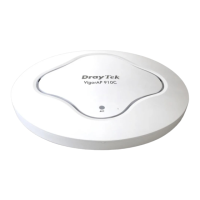VigorAP 910C User’s Guide
25
network through an access point or AP router.
802.11 Ad Hoc – An ad-hoc network is a network where
wireless stations can communicate with peer to peer (P2P).
Power Saving Mode - Choose the power saving mode for such
device.
CAM – Choose this item if it is not necessary to
perform
power saving job.
Power Saving Mode – Choose this item to get into
the
power saving status when there is no data passing
through
the access point.
RTS Threshold- Set the RTS threshold of wireless radio. Do
not modify default value if you don’t know what it is, default
value is 2347.
Fragment Threshold - Set the Fragment threshold of wireless
radio. Do not modify default value if you don’t know what it is,
default value is 2346.
Security Policy
Security Policy - 802.11 standard defines two mechanisms for
authentication of wireless LAN clients: Open Authentication
and
Shared Key Authentication.
Choose one of the security modes from the drop down list. If
you choose OPEN or SHARED, you have to type WEP
information.
OPEN – Open authentication is basically null
authentication algorithm, which means that there
is no
verification of the user.
SHARED – It works similar to Open authentication
with
only one major difference. If you choose OPEN
with WEP
encryption key, the WEP keys is used to
encrypt and
decrypt the data but not for authentication.
In Shared key
authentication, WEP encryption will be
used for
authentication.
If you choose WPA-Personal or WPA2-Personal, the
corresponding WPA settings will be listed as follows.
You
have to choose the WPA algorithms and type the
pass
phrase for such security mode.
WPA Algorithms – Choose Temporal Key
Integrity
Protocol (TKIP) or AES for data
encryption.
Pass Phrase – Please type 8 to 63
alphanumerical
characters here.
WEP
WEP Key Length - WEP (Wired Equivalent Privacy) is a
common encryption mode. It is safe enough for home and

